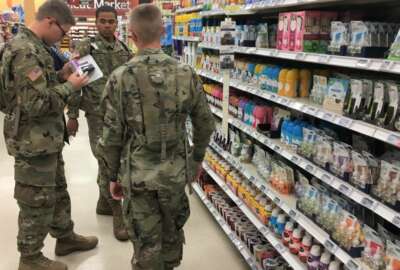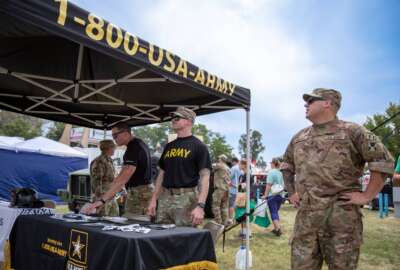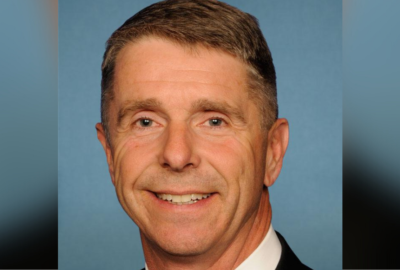Science gives a boost to identifying long-lost military members
DNA has long been used to identify human remains. Such is the case at the identification lab operated by the Defense POW/MIA Accounting Agency. Now some new...
DNA has long been used to identify human remains. Such is the case at the identification lab operated by the Defense POW/MIA Accounting Agency. Now some new scientific methods have emerged called next-gen sequencing. To go deeper into what that is and how it can help, the Federal Drive with Tom Temin spoke with DNA operations director at the Armed Forces Medical Examiner System, Tim McMahon.
Interview Transcript:
Tom Temin And just what is the connection between the Armed Forces medical examiner system, where you run the DNA operations and the POW MIA accounting agency?
Tim McMahon So the connection is a partnership, and this partnership goes back to 1991. The DPA or the Defense POW/MIA Accounting Agency and its predecessors have been around since going back to 1972, when they were the central identification lab in Thailand and in Vietnam recovering. And in 1984, geopolitical thaw between President Reagan and Vietnam. Vietnam unilaterally turned over some unknown service members from Vietnam. In 1991, with the advancements progressing into DNA technology. Basically, our ability to Xerox copy DNA, so to make millions and millions of copies, which was developed in 1987 that allowed DNA to transition into the forensic field for human remains identification. In 1991, we used what was called mitochondrial DNA. And this is DNA that comes from your mother. So we can trace you back through your maternal side. We were able to assist in the identification of a Vietnam unknown. Additionally, in 1991, at the end of Operation Desert Storm, there were a number of U.S. service members who could not be identified and DNA had to be used to identify those. So basically, 1991 is what solidified DNA to be used in both current day operations and to assist with the identification of our past accounting service members. Within DoD, the Armed Forces Medical Examiners system is mandated to determine the cause and manner of death of any service member in a current date of operation. This includes are highly talented doctors, the forensic pathologist or medical legal death investigators. Our division of forensic toxicology determines if there’s a toxicological. And then there’s the DNA lab or the Armed Forces DNA identification lab. So when you think about DNA and you look back at World War Two, Korea and Vietnam, DNA wasn’t even thought about or identified until 1953, when the armistice for Korea was signed. Our ability to Google Translate DNA, that is to sequence DNA and determine how it reads really didn’t come about till 1976. So at the end of the Vietnam conflict. So we don’t have any direct references meaning that service member who died, I don’t have a direct reference. But in 1992, we started collecting a DNA blood reference card for all active duty reserve and National Guard service members. And because of that, from Operation Enduring Freedom and Iraqi Freedom, there are no unknown military service members.
Tom Temin So therefore, you don’t need reference DNA from someone’s family member, their mother or close relative. You can identify it in the DNA itself.
Tim McMahon Absolutely. So for example, Tom, if you were a service member, I would have your card. If you passed away, I could pull that card and I have a direct reference. You transitioned into the next part, which is a great thing, is to assist. So the Defense/POW MIA Accounting Agency is its own agency. They are mandated with the recovery and identification of all of our World War two, Korea, Vietnam, Cold War and Eldorado Canyon, which is the bombing of Bolivia. The missing from those wars. To do that, for us to support them, we do all of the DNA testing for human remains, for all of DoD. So the DPAA will go and recover remains from World War Two. They can go to Papua New Guinea. They can recover a downed airplane. They will then take it to their laboratories where they do their forensic anthropology, the forensics, entomology, which is a big word for looking at dental, the teeth. And they will look at stature and things like that.
Tom Temin We are speaking with Dr. Tim McMahon. He’s director of DNA operations at the Armed Forces Medical Examiner system. So there’s this something coming in new next gen sequencing. Can this help with some of the very old remains where it’s pretty safe to say there are no relatives living anymore?
Tim McMahon Yes. The next generation sequencing, it’s actually two fold. We developed the first method for forensics in 2016, and it was designed to work with what we call chemically treated samples. So at the end of the Korean War, there were about 4,000 sets of remains turned over to the United States. About 862 of those could not be identified. They wanted to preserve them, to keep our heroes in the best state. So they embalmed them. Well, we know now that that’s the worst you could do to DNA. It took us 16 years in science to catch up, and we were able to do next generation sequencing, but that was just to sequence the mitochondrial genome. What do we do when we have a service member? The only living relative is a paternal niece. So through the service members brother, the niece. That doesn’t have any current testing method for it. So we have developed what we call a single nucleotide polymorphism test. If you’re following the news, it’s basically the same thing that Ancestry.com in 23 and me do and that investigative genetic genealogy. But we made it to work with highly degraded DNA, and so that now will allow us to assist with the identification of individuals who previously did not have what we call a viable family reference. The other option, potentially, if it works down and we find out that the missing service member was adopted, then we may be able to use the genetic DNA sequence, we call it, from the bone to potentially search one of the searchable databases and have a genealogist help us find a viable reference.
Tom Temin Is there a large inventory, therefore, of missing but found service members that are unidentified that are either embalmed? As you mentioned, there are still some of them, I suppose. And then what about new ones that might come in which you would not embalm? But if it’s from Vietnam or World War Two, there’s nothing to embalm. It would break bones.
Tim McMahon So we work typically in bones on our past accounting side, and that’s to support the DPAA. There are, if you look across the wars, there were about 72,000 missing from World War two. The DPAA thinks that there’s about 36 to 38,000 of those that are recoverable. And then there were initially 8100 missing from Korea. We’re down to about 7500, we’ve identified over 600. And then Vietnam were at about 1500 that need to be recovered and identified. So to answer your question, inherently, if they go into a country and find them where they crashed or died, even though those bones have been in the field for 60, 70, 80 years, we actually have methods that make them work very well. To answer your question about, are there remains in the lab? We are always working new cases through either recoveries, the DPA going out and doing field recoveries, or they will disinter unknowns from American border monuments and cemeteries. For example, the Cabanatuan prison camp from World War Two in the Philippines. In a 48 hour period, the Japanese allowed the prisoners of war anyone who died to bury everyone in one grave. So there’s a thousand graves there with multiple people. So we’re working to disinter and ID those. The tests that we do, we report at about 300 tests a month. We’re looking to do close to 4,000 of those a year. And that led to supporting 162 new identifications last year.
Tom Temin So this is really painstaking work, isn’t it?
Tim McMahon It is. Unlike your state and local crime lab or my current day operation lab, where we have such fresh new samples, and there we process at once. We take the unknown sample, we do the short tandem repeat test, we take the card, we do it, they match and you’re done. Because of the damage, we actually have to do everything in duplicate. So different scientists do it. The two answers have to match and then we will search our database. That’s an important aspect, since 1992, with the help of our service casualty offices for Army, Air Force, Navy and Marines, they’re the belly buttons for the families. They’ve actually collected family references for us. And we’ve created this database. So for the original 8100 missing from the Korean War, I have references for 92% of those. That’s why we can support those identifications.
Tom Temin Wow. So the World War Two ones could remain and forever unknown because there’s just no cross-reference.
Tim McMahon Well, that’s really one of the biggest misconceptions out there.
Tom Temin Set us right.
Tim McMahon Yeah. So you would think about that when you hear in the news, the greatest generation, the World War two, we’re losing a number of vets per day, but because we use lineage markers, meaning that, Tom, if you were missing and you had a brother, a sister or your maternal aunt had kids, I can use them as references to help assist in the identification of you. And so we can go back, and that the farthest I’ve ever seen that we’ve made an ID is with a seven great niece to a Vietnam unknown.
Tom Temin There’s been that have been enough generations in that family to have such a thing. They marry young in that family.
Tim McMahon Exactly. But let’s take Tarawa, for instance, the Battle of Tarawa. They’re a little over, and my numbers are close, a little over 489 missing Marines. For those 489 missing Marines, I have references currently on hand for 85% of them. So the reason is it’s kind of like your toolbox. When I go into my toolbox, I have 7 or 8 different sized screwdrivers, because the screws are all different size. So the more screwdrivers you have, the more successful I’m going to be in fixing what I need to do. So for us, we utilize every DNA test that’s available, as well as develop our new ones. And that gives us the breadth of the ability to use multiple lines of references. And it comes down to when you think about criminal forensics, you’re asking who against the world’s population committed that crime. So you need that direct reference. But when you’re dealing with a missing persons like we are, we can utilize lineage markers. We can utilize snips, we can utilize everything. And that opens up the pool of references for us.
Tom Temin Right. So the essential new development in recent times then is the ability to identify someone from other than their mother’s DNA, basically.
Tim McMahon Right. The beauty of it is to test that we did, that new test you’re talking about. That turns every reference that I’ve collected since 1992 into a new reference. So it doesn’t invalidate the mother’s reference that I collected back in 1992. I don’t have to go out and get a new reference. I get to use her still to identify her missing son. And so that’s the beauty of it, is we don’t have to go out and recollect all of our references. The new method allows us to use all the references we already collected, but just in multiple forms now.
Tom Temin And when doing this type of work, I imagine it occurs to you and the people you work with and the people that work in your division, consider this sacred work.
Tim McMahon We do, and I’ll give you an idea. So, Tom, we have to work in the blind, we call it. So we don’t want to have any cognitive bias. So when a sample comes to us, it comes in with a unique case number. However, when that individual is identified, that service members identify, we actually put the identification notice on our board in our hallway. And we have a big United States map. And then a pin goes in that service members hometown. So they may come in unknown, but they leave as an identified hero. And that’s how we tie our people to the mission, and they love it. It’s sacred for them to do that.
Copyright © 2025 Federal News Network. All rights reserved. This website is not intended for users located within the European Economic Area.
Tom Temin is host of the Federal Drive and has been providing insight on federal technology and management issues for more than 30 years.
Follow @tteminWFED






